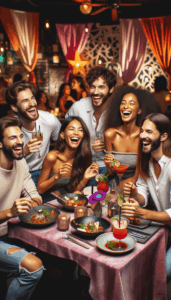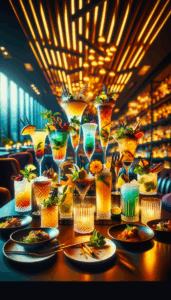Fast Casual Dining’s New Trend: Alcohol Offerings Surge
- Phone: +1(833)PHX-Geek
- 712 H St NE Suite 1904 Washington, D.C. 20002
Are you looking to come to Toast POS? Follow this link to sign up and get a free quote from your local Toast Rep. They will come out to your restaurant, and give you a free, no obligation quote.
Introduction
The fast casual dining sector is undergoing a significant transformation as establishments increasingly incorporate alcohol into their menus. This shift aligns with the booming alcoholic drink market, projected to surpass $261 billion this year. Notably, nearly half of this spending occurs within bars and restaurants, emphasizing the lucrative opportunity for fast casual operators. As consumer preferences evolve, offering a curated selection of alcoholic beverages has become essential for attracting patrons seeking a more diverse dining experience. 
The rising interest in alcohol consumption in casual dining settings reflects changing societal norms. Millennial and Gen Z demographics, characterized by their willingness to explore new flavors and experiences, often prioritize alcohol when selecting dining venues. Fast casual establishments are keenly aware of this trend, and as such, many are adapting to meet these customer expectations. By understanding the dynamics of the alcohol market, restaurants can position themselves effectively to capture this growing audience.
Moreover, offering alcohol allows fast casual eateries to compete more aggressively against full-service restaurants. As preferences shift, the ability to serve a well-thought-out drink menu can create a sense of occasion, transforming a simple meal into a more memorable experience. This strategic advantage not only enhances customer satisfaction but also builds brand loyalty among patrons who value these offerings.
Operators in the fast casual segment often experience substantial profit margins when selling alcoholic beverages—typically ranging from 60% to 70%. This staggering profitability makes alcohol an attractive proposition, especially when compared to traditional food offerings. As margins for food can often be tighter due to ingredient costs and preparation time, the ability to sell drinks at such high rates presents a unique financial opportunity for these establishments.
Profitability is not merely a matter of numbers; it also plays a crucial role in the overall business strategy. By introducing alcohol into the menu, fast casual restaurants can significantly boost their average check size. Patrons who order drinks alongside their meals contribute to increased sales volume, promoting a more robust financial model. This strategy not only mitigates the risk of competing on price alone but also facilitates investment in higher-quality food offerings and improved dining experiences.
Furthermore, leveraging alcohol sales can lead to increased foot traffic during off-peak hours. Happy hours and special promotions on drinks can draw in crowds at times when traffic is typically lower, thereby maximizing operational efficiency. In an industry where margins are key, utilizing alcoholic beverages to enhance profitability becomes a prudent strategy for fast casual dining establishments aiming for long-term success.
Millennials and younger generations are shaping the dining landscape, making their preferences crucial for fast casual restaurants seeking growth. This demographic tends to place a high value on dining experiences that offer both quality food and unique beverage options. Fast casual establishments that recognize this trend are better positioned to attract these younger consumers, who often seek out places where they can socialize and enjoy a drink. 
By offering distinctive cocktails or local craft beers, fast casual eateries can create an appealing atmosphere that resonates with millennial preferences. This connection between alcohol and dining experience is essential, as these consumers often prioritize establishments that cater to their desire for both quality and variety. Establishments that invest in creating a unique beverage program can differentiate themselves in a crowded market, drawing in customers who are eager to explore.
Additionally, the use of social media can amplify the appeal of these alcoholic offerings. By showcasing innovative drink options or themed cocktail nights, restaurants can leverage platforms like Instagram and TikTok to reach a younger audience. This engagement not only enhances brand visibility but also cultivates a community of patrons who feel connected to the restaurant's identity and offerings.
In a competitive dining landscape, fast casual establishments have found a powerful tool for differentiation in the form of unique cocktails. The ability to offer signature drinks that reflect the restaurant's brand identity can create a memorable experience for patrons. By crafting cocktails that align with the restaurant's theme or ethos, operators can leave a lasting impression on diners, motivating them to return.
This strategic differentiation is crucial in an era where customers are inundated with options. Unique cocktails can act as a focal point for marketing efforts, allowing establishments to promote their brand’s creativity and culinary skill. Additionally, featuring local ingredients or seasonal flavors in cocktails can further enhance the dining experience, appealing to consumers’ growing interest in sustainability and local sourcing.
Moreover, a well-executed cocktail program can serve as a conversation starter among patrons. This social aspect not only enhances the dining experience but also fosters a sense of community within the restaurant. As consumers increasingly seek out venues that provide both food and drink, the importance of thoughtful cocktail offerings cannot be overstated. 
Conclusion
The trend of fast casual establishments incorporating alcohol into their menus represents a significant shift in the dining experience. By understanding market dynamics, leveraging profit margins, appealing to millennials, and focusing on unique cocktail offerings, these restaurants can position themselves favorably amidst growing competition. As the alcohol market continues to expand, fast casual dining stands poised to thrive by embracing this evolving consumer demand.